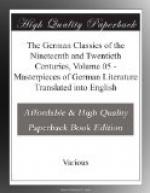Persevering exercise in the study of that by virtue of which the characteristic in things is a positive principle, must preserve him from emptiness, weakness, inward inanity, before he can venture to aim, by ever higher combination and final melting together of manifold forms, to reach the extremest beauty in works uniting the highest simplicity with infinite meaning.
Only through the perfection of form can Form be made to disappear; and this is certainly the final aim of Art in the Characteristic. But as the apparent harmony that is even more easily reached by the empty and frivolous than by others, is yet inwardly vain; so in Art the quickly attained harmony of the exterior, without inward fulness. And if it is the part of theory and instruction to oppose the spiritless copying of beautiful forms, especially must they oppose the tendency toward an effeminate characterless Art, which gives itself, indeed, higher names, but therewith only seeks to hide its incapacity to fulfil the fundamental conditions.
That lofty Beauty in which the fulness of form causes Form itself to disappear, was adopted by the modern theory of Art, after Winckelmann, not only as the highest, but as the only standard. But as the deep foundation upon which it rests was overlooked, it resulted that a negative conception was formed even of that which is the sum of all affirmation.
Winckelmann compares Beauty with water drawn from the bosom of the spring, which, the less taste it has, the wholesomer it is esteemed. It is true that the highest Beauty is characterless, but so we say of the Universe that it has no determinate dimension, neither length, breadth nor depth, since it has all in equal infinity; or that the Art of creative Nature is formless, because she herself is subjected to no form.
In this and in no other sense can we say that Grecian art in its highest development rises into the characterless; but it did not aim immediately at this. It was from the bonds of Nature that it struggled upward to divine freedom. From no lightly scattered seed, but only from a deeply infolded kernel, could this heroic growth spring up. Only mighty emotions, only a deep stirring of the fancy through the impression of all-enlivening, all-commanding energies of Nature, could stamp upon Art that invincible vigor with which from the rigid, secluded earnestness of earlier productions up to the period of works overflowing with sensuous grace, it ever remained faithful to truth, and produced the highest spiritual Reality which it is given to mortals to behold.
In like manner, as their Tragedy commences with the grandest characteristicness in morals, so the beginning of their Plastic Art was the earnestness of Nature, and the stern goddess of Athens its first and only Muse.
This epoch is marked by that style which Winckelmann describes as the still harsh and severe, from which the next or lofty style was able to develop itself by the mere enhancement of the Characteristic into the Sublime and the Simple.




